So conventional flash synchronization is limited to this slow speed. But Olympus bounced back with another innovative solution to this setback of SLR design which has been long troubled the industry. By designing with a new conceptual full-synchro flash unit, the Olympus F280* that works with the principle of FP Bulbs (Focal Plane) that the electronic flash will actually emit with series of short burst of light that extends the flash duration to cover the whole shutter sequence from start to finish. It allows use of every camera shutter speed, even a super fast 1/2000 sec., opening the way to a vast new range of creative flash techniques.
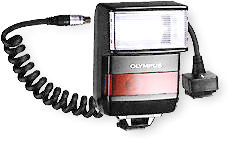 |
* Olympus FP Flash: By making the flash duration some 40 times longer than conventional flash (about 1/25 sec.), this system solves the synchronization problem to make flash available at any SLR shutter speed. |
Note: OM-3Ti and OM-4T(i) have two extra pins on its hot shoe which are required to use for controlling the F280 flash to sync at all shutter speeds up to 1/2000 sec.
But you need not have to rush out and buy the flash for your OM1 or OM2(n) (neither It works with OM3 and OM4), instead, the fascinating FP flash mode is only workable with OM3Ti and OM4Ti. However, you can still enjoy normal TTL, normal AUTO or Manual with respective models where it relates. Unfortunately, neither of the earlier OM1 and 2 series models were designed with such features incorporated within the camera to take advantage of the new flash capability and thus, it brings little benefit with these bodies other than the OM3Ti and OM4Ti models. However, as explained in earlier sections, the principle of the electronic FP flash was evolved from with the use of FP (Focal plane) flash bulbs, which means they will work throughput the higher shutter speed from 1/60 to 1/1000 sec speed range. Both OM1(n) and OM2(n) series models have similar working range for flash and flash bulb (see below):
|
|
||||||||||||||||||||||||||||||||||||||||||||||||||||||||||||||||||||||||||||||||||
Early OM1 and OM2 bodies would require you to set the flash mode selector to either "X" or "FP" setting accordingly. But the upgraded versions has refined and designed with, when used with any dedicated Olympus flash units in combination with Accessory Shoe Type 4, the camera will automatic X-sync regardless of the position of the FP/X switch is pointing at.
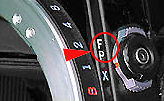 |
Was the slow shutter speed the only problem ? No quite. The next was the designing of the camera's with an removable accessory shoe. I would assume when they decided to launch the OM1, the OM2 was already in the mid of development. |
The two models are vastly different in its metering function and exposure control, especially in relation to TTL flash which was so different in its theory and function than any other flash design prior to it. Naturally, it may post some potential problems with all the uncertainty of the new flash system and how the new dedicated flash unit would be - IF the OM1 was to be given with a FIXED accessory shoe that came with another mysterious secondary contact atop. That may present a more logical answer. If it is not, then Olympus could have created a very troublesome flash compatibility issues then. See below and you may agree with me:
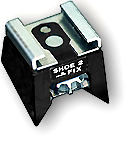 |
Accessory Shoe Type 1 or early "Fix" Type shoe for M1 and OM-1's has no viewfinder ready light feature since they isn't any additional terminal apart from the main X-contact (F); Shown at left is a Accessory Shoe Type 2 designed for early OM-2 bodies for TTL flash which will ONLY work with Quick Auto 310 flash, it has an additional contact at the hotshoe. |
The extra contact require an additional pin which make it NOT usable with any M1 or OM-1 bodies which has only a single input socket (B) while early OM-2 bodies has two sockets (A). The OM1n model has a new designs when used with Accessory Shoe Type 4 and OM2n bodies in particular, has full blown TTL flash capabilities when used in conjunction with T series flash. These bodies have one main socket and two inline pin inserts (E) which clearly illustrated from the top with two additional terminal contacts other than the main X-sync (C).
Important: Shoe 4 should be the correct shoe type for all OM-1n and OM2n bodies. It permits manual and normal auto flash control But in the case of OM2n bodies, it will perform TTL flash exposure control; further, it will automatically sets X-sync at the shoe, and via a third contact to provide viewfinder flash ready/sufficient flash LED. Is it possible to use Accessory Shoe Type 1 or "Fix" type shoe on OM-1n bodies ? Yes. Because the Shoe 1 has only one pin and thus it is not possible to use those two pins accessory shoe(s) with earlier OM1 or M1 bodies which has only one socket. In the case of the original OM2 model which has two inputs, Accessory Shoe 2 should be the right type to use with older Quick AUTO 310 TTL flash.
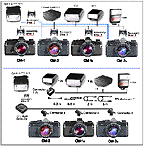 |
<<-- Download a PDF file (165k) for connectibility of various Olympus Flash models and the use of connector. If you don't have a PDF reader, Click HERE for another HTML file with two JPEG images (44k) each. |
The Quick AUTO 310 has long being discontinued, IF you intend to use OLDER OM2 bodies with newer T series flash models such as T20 or T32, you have to change the accessory shoe to Shoe Type 3 (Olympus advised Shoe 3 is NOT recommended to use it with Quick AUTO 310 in TTL mode). Confusing ? May be, but unlikely that when you are owning a few camera bodies of different times and types along with a few versions of the flash types. But generally, it should not be having too much incompatibility among all these combinations.
 |
 |
 |
 |
 |
 |
In most cases, by looking at the hotshoe we should be able to determine the model within a series. |
|||
But since it is a removable type, that can be difficult to make a conclusion. Please take note of the sole pin inside the socket (2nd photo). The far right is a OM-2n accessory shoe socket with two extra pin inserts and it indicates it would require Shoe Type 4. Some users explained it needs to have detachable design in order to enable it to work with OFF camera TTL flash. But early OM1/OM2 has a few ways to connect flash to camera, like you will need a remote sensor that fitted into the accessory shoe 1 (OM1) and linked with the bounce grip and enable auto bounce flash with Quick Auto 310, other than for off camera operation.
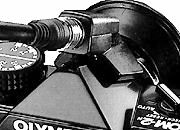 |
|
The OM2 needs an Auto cord with the accessory shoe 2. But for the later OM2n, Olympus replaced them to use with T32.T20 with an TTL auto connector Type 4 with an TTL auto cord to use with the Bounce Grip 2. NOTE: T-series flashes CANNOT work properly on the earlier Bounce Grip 1, while on the other hand, older Quick AUTO flash 310 DO NOT work on the Bounce Grip 2. BOTTOM line: The third OM model, OM10 has an accessory shoe affixed permanently and ALL subsequent OM SLRs that came with or without TTL flash also has it fixed on the pentaprism, Obviously, the confusion it has created to the OM users along with the tedious in maintenance & support are not practical anymore.
 |
 |
Accessory Shoe Type 4 should be the correct shoe type for OM1n and OM2n bodies. The fixed non-detachable hotshoe found on other OM SLR models such as OM40, OM2SP, OM-3 and OM4 are essentially similar to the Shoe 4 design. |
What significant advantages it brings when used with OM1n and OM2n ? It permits manual, normal auto flash with OM1n with an additional benefit of enabling Direct TTL flash metering with OM2n; it also automatically sets X-sync at the shoe regardless where the F/X flash mode selector is pointing at and the third contact atop will provide viewfinder flash ready/sufficient flash light only when you used any of the dedicated Olympus T-series flash units. Speaking of Olympus flash unit can be quite a lengthy story if you trace back to the days of the Olympus OM2 was introduced. The common T-series was not existed yet. In fact, when the OM2 was introduced, despite there is a big "huhah" about its potentials; Olympus has NOT got a TTL flash ready for its OM2 !
 |
|
Olympus has a few other popular flash units such as AUTO flash 300 and another two smaller flash units, PS200, PS200 Quick etc. which was mainly designed for the OM1(MD) to operate either in AUTO or manual flash control. The first TTL flash was actually based on the Quick AUTO 300 and named as Quick AUTO 310 and it was only made available AFTER OM2 has hit the market for a while.
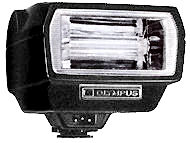 |
Some information relates to a few popular NON-TTL Olympus AUTO flash: |
Olympus NON-TTL flash Quick AUTO 300 : With a guide number of 34 (ASA 100, meters), this is the most powerful! flash unit generally available, offering a wide coverage to give even illumination throughout the picture area of a 24mm super wide-angle lens. It provides fully automatic flash capability at f4, f5.6 & f8. Hl and LOW manual settings are possible. Also incorporates an auto check lamp. Working off 4 penlight batteries with any direct contact camera. Can be used together with the Bounce Grip, permitting a choice of various power sources.
 |
OLYMPUS PS200 The PS200 operates on two 1.5V penlight batteries for use with all the current OLYMPUS cameras and any other cameras with hot shoe contact. Guide number 14 (in meters) (or 45 in feet) ASA 80-100. Suitable to daylight type color films. Recycling time approximates 7 sec. and number of flash 200 times with fresh alkaline batteries. Measures 31 X 55 X 64mm (1.2" X 2.2" X 2.5"), weighing 759 (2.6 oz.) without batteries. |
 |
OLYMPUS PS200 Quick The PS200 Quick is a compact electronic flash unit that operates on four 1.5V penlight batteries (alkaline or carbon/zinc) for the use with the hot shoe cameras. This unit features a short ;recycling time from 2 sec. to 3 sec. .Guide numbers 14 in meters (45 in feet), for color and B&W films, ASA 80-100. Suitable to daylight type color films. Flash duration 1/1000 sec. Number of flash about 200 times with alkaline batteries. Measures 32 X 73 X 71mm (1.3" X 2.9" X 2.8"), weighing 959 (3.4 oz.) without batteries.
A latest inclusion of a Non-TTL electronic OLYMPUS Flash PS20 - Originally designed for Olympus OM2000
 |
Type: Clip-on hot shoe type |
Coverage Angle: Standard:
equivalent to 35 mm lens angle of view; With wide-angle converter: Equivalent to
24 mm lens angle of view
Color Temperature: Standard: 5,800° K; With wide-angle converter: 5,800° K
Camera Mount: Hot shoe
Electronic Contact: Hot shoe. Direct contact
Flash Duration: Auto: Approx. 1/30,000-1/1,200 sec.; Manual: Approx. 1/1200 sec;
Number of Flashes: 280 times (with two AA LR 6 alkaline batteries)
Flash Modes: Auto-1 (ISO 100 : F2.8), Auto-2 (ISO 100 : F5.6), Manual
Power Source: Two AA LR 6 alkaline batteries or KR 15/51 Ni-Cd batteries
Dimensions: 56 (W) x 28 (D)x 82 (H) mm
Weight: Approx. 70 g (excluding batteries)
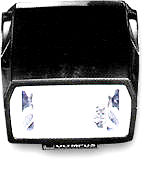 |
Quick Spec Sheet on Olympus TTL Quick AUTO 310: Based largely on the NON-TTL Quick AUTO 300, which has a similar output and a slightly HIGHER guide number than that of the TTL Auto Flash T32, Quick AUTO 310 is rated at 34 (ASA 100, meters). |
This is the most powerful! flash unit generally available during its time, offering a wide coverage to give even illumination throughout the picture area of a 24mm super wide-angle lens. It provides fully automatic flash capability at f4, f5.6 & f8. Hl and LOW manual settings are possible. Also incorporates an auto check lamp. Working off 4 penlight batteries with any direct contact camera. Can be used together with the Bounce Grip, permitting a choice of various power sources.
 |
Early OM2 body can perform TTL flash via Accessory Shoe Type 2 directly with Quick Auto 310 flash. The adequately powerful Unit can also be extended as an modular handle flash with a bracket, Bounce Grip and auto cord. |
The combination offers a new level of flexibility as the bounce grip can now offer bounce and tilt capabilities which was previously unavailable in this class. The very practical and well-spec Olympus T32 which was aimed to replaced the Quick Auto 310 has some of the basic features built-in along with many Extras incorporated to expand its TTL functions further - making the T32 one of the LONGEST serving flash model in the market and naturally is is also the most popular Olympus flash unit ever. NOTE: Power Bounce Grip 1 is originally designed for Quick Auto 300 and TTL Quick AUTO 310 and Power Bounce Grip 2 is designed for the T-series flash units such as T32 or T20. Newer T-series flash units may not function probably with earlier Bounce Grip 1; further, Grip 1 is not designed to use with NiCd cells.
Power Bounce Grip Version 1 & 2: Some of these useful accessories have been introduced way back from the mid-seventies; there were some upgrades to take advantage of newer electronic and flash capabilities. Other than the hot shoe issues mentioned earlier, some of which may also have some compatibility problems. A good example is the Power Bounce Grip 1 & version 2. Other than cosmetical difference, the Power Bounce Grip 1 was originally designed for older Quick Auto 300 and 310 flash units; version 2 is more specifically designed for the T-series flash models. However, the Grip has some backward compatibility problem because T-series flashes don't work on the Grip 1 while older Quick AUTO flash units don't work on the version 2.
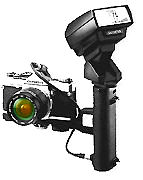 |
Besides, there is a shutter release button that can be connected to the remote socket on a motor drive or winder via a M.Grip cord. Grip2 is also more flexible with greater operation ease with its tilts improved to 90° from 75° and downward action extended to 20° from 15° of Grip1. With TTL almost a standard feature on all later higher end OM models, version 2 also incorporate a 5 pins TTL sync socket with a PC terminal permanently affixed. Another considerate feature is being, version 2 can now facilitate the use of NiCd cells. |
The unit consists of a bracket and
a removable grip for convenience in carrying and storing. The bracket with a built-in
synch cord connects to the grip instantly. The power switch on the flash activates
both the "AA" batteries in the flash and "C" batteries in the
grip. The recycling time with the T32 is 0.2-9sec. with Alkaline batteries and 0.2-7
sec with Ni-Cd batteries; the number of flashes is increased to 200-1000 in auto
operation (0.2-10sec recycling time and 100~500 flashes for T32 used without Power
Bounce Grip 2). This unit has a Motor Drive release button that allows operation
of the Motor Drive or Winder by the right hand holding the unit. Other than using
the four 1.5V "C" batteries are used (including Ni-Cd batteries) you can
also make use of the external power socket which accepts the output plug of the F.AC
Adapter 2 for extended long shooting sessions. there are five tripod screw holes
provided on the bracket allows free choice of camera position. The camera can be
mounted to either the right or left-hand side of the grip by swiveling the bounce
head 180°.
Note: The
Quick Auto 310 flash cannot
be used. The full-synchro
flash F280 (with TTL Auto Cord F0.6m) can be used, but the batteries in the grip
will not provide extra power. The Flash Extender can be attached to give extra extension,
when the rubber plug at the front of the Extender is removed, but the batteries in
the grip will not provide extra power.
| Previous
| Next | Part II
2/4
| Back |
Index Page of Olympus Flash Photography
| Back |
Main Index Page of Olympus OM1(n) & OM2(n)
Main Reference Map for Olympus T32 Flash: HTML |
PDF
File (163k)
Olympus T45, T32, T20, F280, S20, T10 Ring, T8 Ring, T28 Macro Single, T28 Macro Twin, TTL Quick AUTO 310, Quick AUTO 300,
PS200, PS200 Quick and T Power Control Version 1
| Back |
to Index Page of OM1(n)
| Back |
to Index Page of OM2(n)
| Back |
to Main Index Page of OM1(n) & OM2(n)
Olympus
OM-1(n): Main Index Page (5 Parts) | Camera Operations (6 Parts)
Specifications: HTML | PDF | Main Reference Map:
HTML | PDF (217k)
Olympus OM-2(n):
Main
Index Page
(6 Parts) | Camera Operations (9 Parts)
Specifications: HTML | PDF (48k) Main Reference Map: HTML | PDF (203k)
Olympus
OM-2SP: Camera Operations | Other Issues
Specifications: HTML | PDF | Main Reference Map: HTML | PDF
Shared Resources: Supplementary Articles:
TTL
Metering,
Depth
of Field,
Shutter
Speed
& Aperture
Motor
Drive and Power Winder: Main Index Page (4 Parts)
Motor Drive 1 | Motor Drive
2
| Winder 1 | Winder 2
Flash Photography: Main Index Page (4 Parts)
T45 | T32 | T20 | F280 | S20 | Qucik AUTO 310 | QA300, 200, 200S
Macro-Photography: Main Index Page (3 Parts)
Manual for Photomicro Group (3 Parts) NEW upload !
Macro Flash Units: T10 Ring Flash, T28 Twin, T28 Single,
T8 Ring Flash
Accessories: Databack 1-4 | Screens | Finder Accessory | Remote | Cases
Zuiko
Lenses: Construction in progress..
Glossary of Photography
A good external source for used Instruction
Manuals
for various OM SLRs and Accessories.
| Message Board | for
your favourite Olympus
OM-1(n)
and OM-2(n)
series models
| Message
Board | for your Zuiko
Optics in a shared environment
| Message Board | Specifically for Dispose or Looking for OM Photographic
Equipment
About this photographic site.
Home - Photography in Malaysia |
Copyright © 2000. leofoo ®. MIR Web Development Team.
Site
& Message Board Maintainers: Mr. Simon Evans <sje@lrc.ruralwales.org>; Mr. Rick
Oleson <rick_oleson@yahoo.com>; Mark Dapoz
<md@dementia.org>
Credit: My old time buddy,
Ahmad
Ikram,
Dr of Rubber Research Institute (RRI), Malaysia
who shares the same passion with me and also lending his OM-1n, OM-4 and the Motor
Drive 1 to me for preparing some images in this site; Mark Dapoz <md@dementia.org>for reminding
some broken links;
Mr Poon of Foto Poon, Ipoh, Mr Richard, Ampang Park, Mr Lim
and Miss Jenny of Foto Edar for their generosity for their OM1(n), OM2n camera
and some Zuiko lenses. Mr Hans van Veluwen for mistakenly using
some content earlier from his OM website; J Sorensen
for providing some useful images to rectify some technical "flaws"; Mr
Gen Holst for helping during the early stages of development of this OM site;
Mr KKLow for some of his earlier images on the OM-1appeared in this website;
Miss Wati and Mirza for helping me
to convert this Operation Manual into a HTML format. Mr MCLau for rectifying
some mistakes made on the earlier preview sites. Site created 'unfortunately' again
with a PowerMac. A personal tribute to the
creator of the OM system and also a site dedicated to all the fans of Olympuses and
Zuiko Optics worldwide. Some of the content
and images appeared in this site were scanned from OM official marketing leaflets,
brochures and instruction manual(s) for educational purposes. Olympus is a registered
tradename of Olympus Optical Inc., Japan.

